Advanced Financial Accounting: Enron Case Study
VerifiedAdded on 2023/06/03
|11
|2823
|218
AI Summary
This study focuses on Enron's use of Mark to Market accounting, SPE application, and stock options compensation scheme. It also analyzes the methodologies used in Enron's annual report and the techniques deployed by the company.
Contribute Materials
Your contribution can guide someone’s learning journey. Share your
documents today.
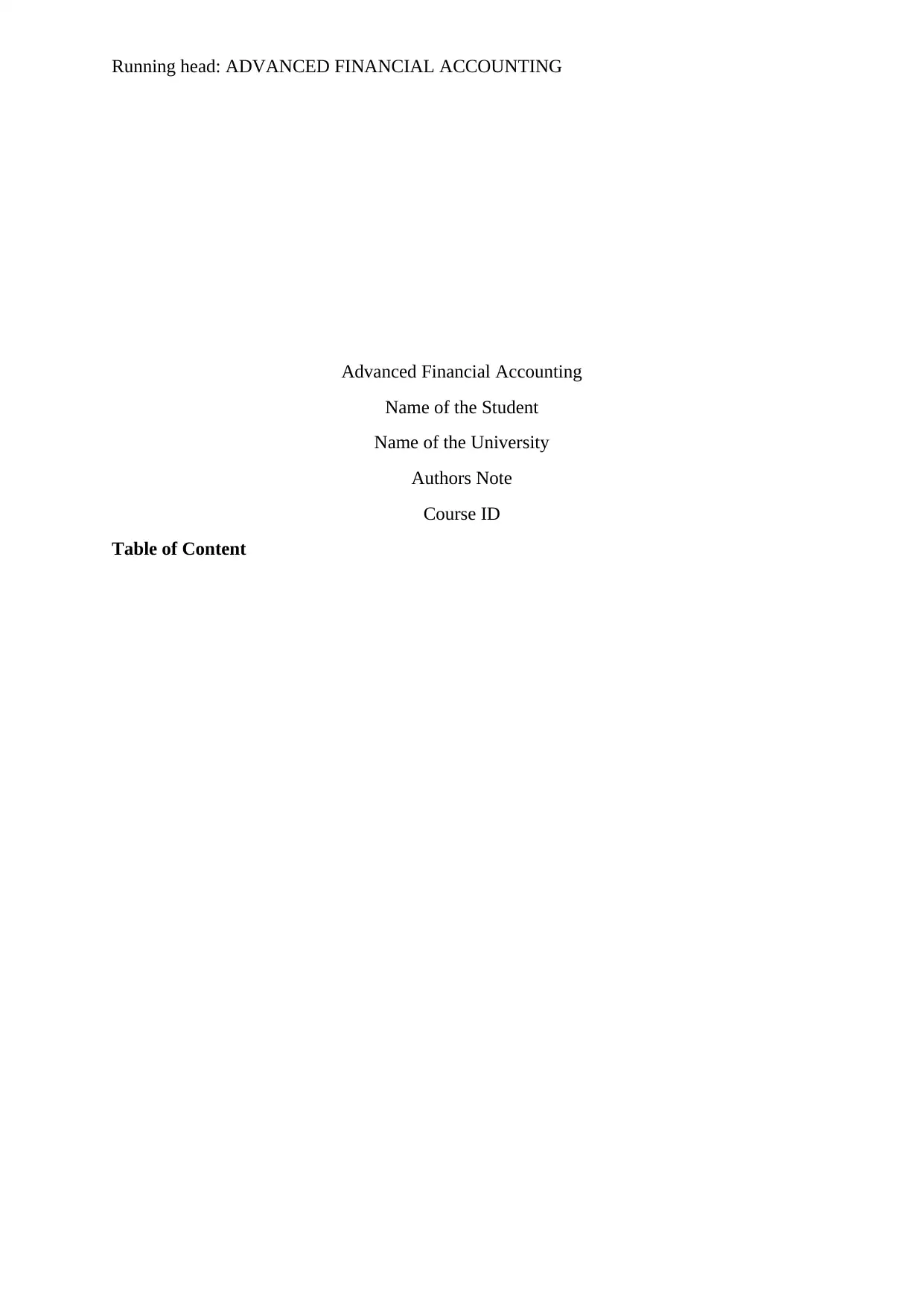
Running head: ADVANCED FINANCIAL ACCOUNTING
Advanced Financial Accounting
Name of the Student
Name of the University
Authors Note
Course ID
Table of Content
Advanced Financial Accounting
Name of the Student
Name of the University
Authors Note
Course ID
Table of Content
Secure Best Marks with AI Grader
Need help grading? Try our AI Grader for instant feedback on your assignments.
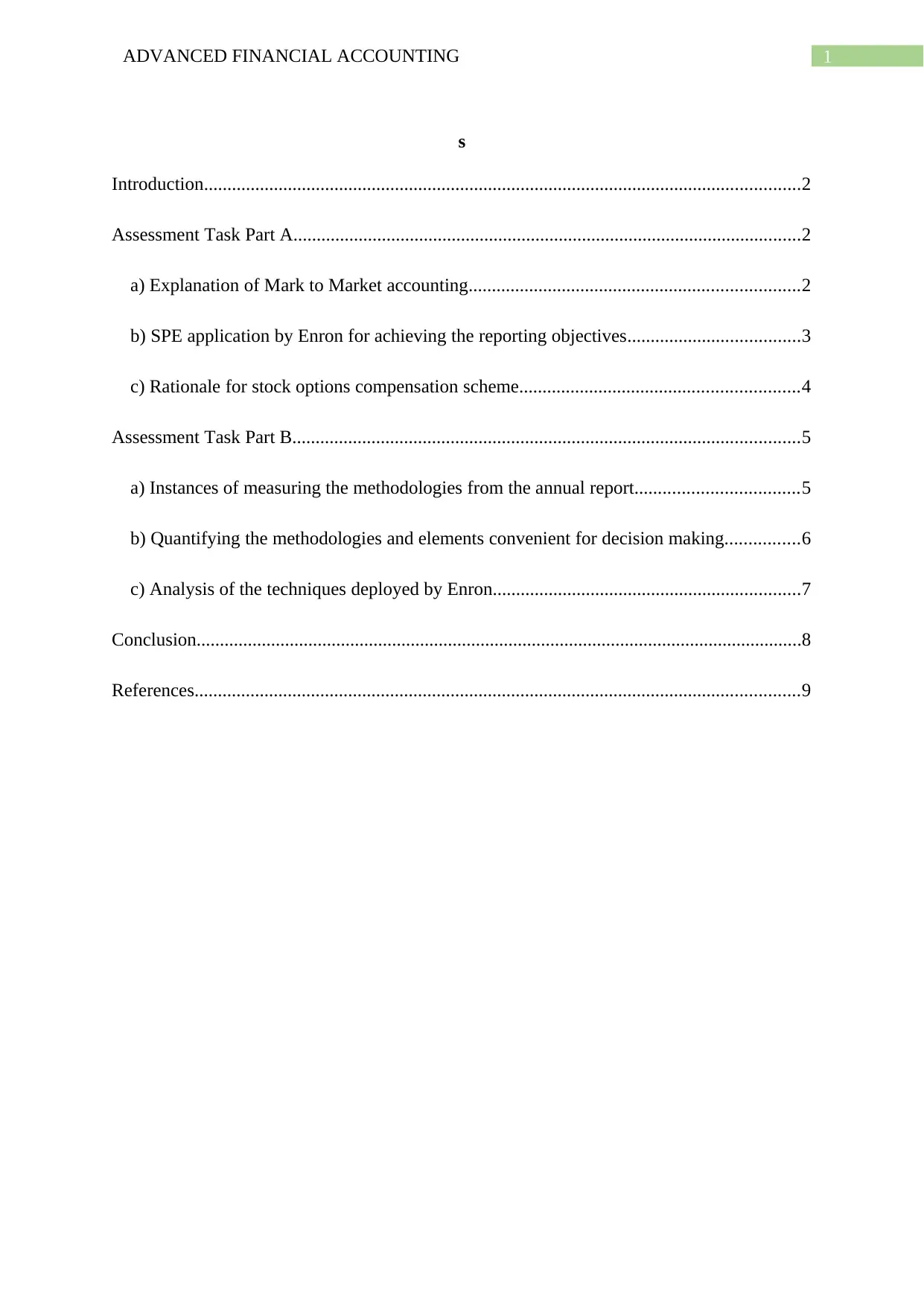
1ADVANCED FINANCIAL ACCOUNTING
s
Introduction................................................................................................................................2
Assessment Task Part A.............................................................................................................2
a) Explanation of Mark to Market accounting.......................................................................2
b) SPE application by Enron for achieving the reporting objectives.....................................3
c) Rationale for stock options compensation scheme............................................................4
Assessment Task Part B.............................................................................................................5
a) Instances of measuring the methodologies from the annual report...................................5
b) Quantifying the methodologies and elements convenient for decision making................6
c) Analysis of the techniques deployed by Enron..................................................................7
Conclusion..................................................................................................................................8
References..................................................................................................................................9
s
Introduction................................................................................................................................2
Assessment Task Part A.............................................................................................................2
a) Explanation of Mark to Market accounting.......................................................................2
b) SPE application by Enron for achieving the reporting objectives.....................................3
c) Rationale for stock options compensation scheme............................................................4
Assessment Task Part B.............................................................................................................5
a) Instances of measuring the methodologies from the annual report...................................5
b) Quantifying the methodologies and elements convenient for decision making................6
c) Analysis of the techniques deployed by Enron..................................................................7
Conclusion..................................................................................................................................8
References..................................................................................................................................9
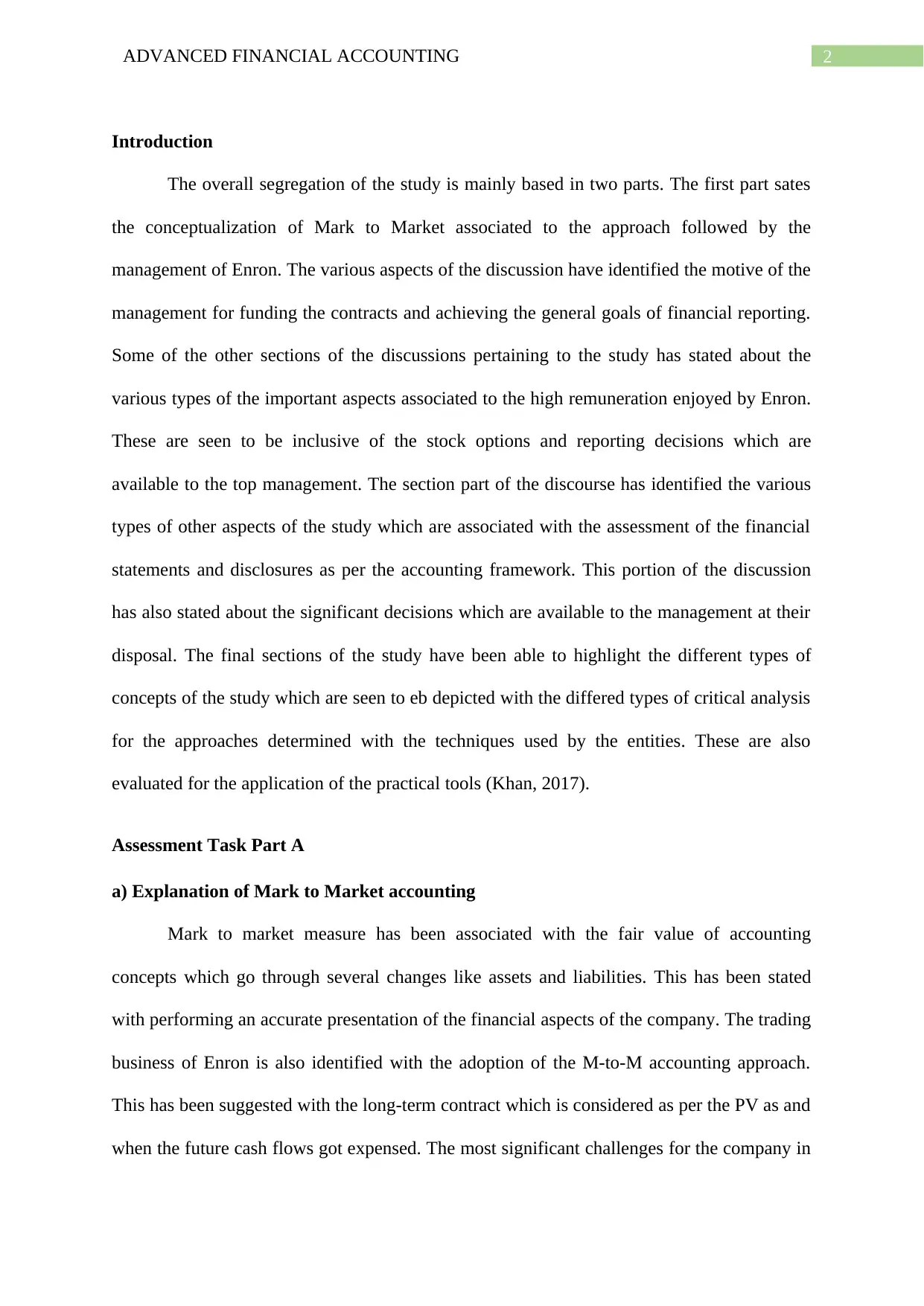
2ADVANCED FINANCIAL ACCOUNTING
Introduction
The overall segregation of the study is mainly based in two parts. The first part sates
the conceptualization of Mark to Market associated to the approach followed by the
management of Enron. The various aspects of the discussion have identified the motive of the
management for funding the contracts and achieving the general goals of financial reporting.
Some of the other sections of the discussions pertaining to the study has stated about the
various types of the important aspects associated to the high remuneration enjoyed by Enron.
These are seen to be inclusive of the stock options and reporting decisions which are
available to the top management. The section part of the discourse has identified the various
types of other aspects of the study which are associated with the assessment of the financial
statements and disclosures as per the accounting framework. This portion of the discussion
has also stated about the significant decisions which are available to the management at their
disposal. The final sections of the study have been able to highlight the different types of
concepts of the study which are seen to eb depicted with the differed types of critical analysis
for the approaches determined with the techniques used by the entities. These are also
evaluated for the application of the practical tools (Khan, 2017).
Assessment Task Part A
a) Explanation of Mark to Market accounting
Mark to market measure has been associated with the fair value of accounting
concepts which go through several changes like assets and liabilities. This has been stated
with performing an accurate presentation of the financial aspects of the company. The trading
business of Enron is also identified with the adoption of the M-to-M accounting approach.
This has been suggested with the long-term contract which is considered as per the PV as and
when the future cash flows got expensed. The most significant challenges for the company in
Introduction
The overall segregation of the study is mainly based in two parts. The first part sates
the conceptualization of Mark to Market associated to the approach followed by the
management of Enron. The various aspects of the discussion have identified the motive of the
management for funding the contracts and achieving the general goals of financial reporting.
Some of the other sections of the discussions pertaining to the study has stated about the
various types of the important aspects associated to the high remuneration enjoyed by Enron.
These are seen to be inclusive of the stock options and reporting decisions which are
available to the top management. The section part of the discourse has identified the various
types of other aspects of the study which are associated with the assessment of the financial
statements and disclosures as per the accounting framework. This portion of the discussion
has also stated about the significant decisions which are available to the management at their
disposal. The final sections of the study have been able to highlight the different types of
concepts of the study which are seen to eb depicted with the differed types of critical analysis
for the approaches determined with the techniques used by the entities. These are also
evaluated for the application of the practical tools (Khan, 2017).
Assessment Task Part A
a) Explanation of Mark to Market accounting
Mark to market measure has been associated with the fair value of accounting
concepts which go through several changes like assets and liabilities. This has been stated
with performing an accurate presentation of the financial aspects of the company. The trading
business of Enron is also identified with the adoption of the M-to-M accounting approach.
This has been suggested with the long-term contract which is considered as per the PV as and
when the future cash flows got expensed. The most significant challenges for the company in
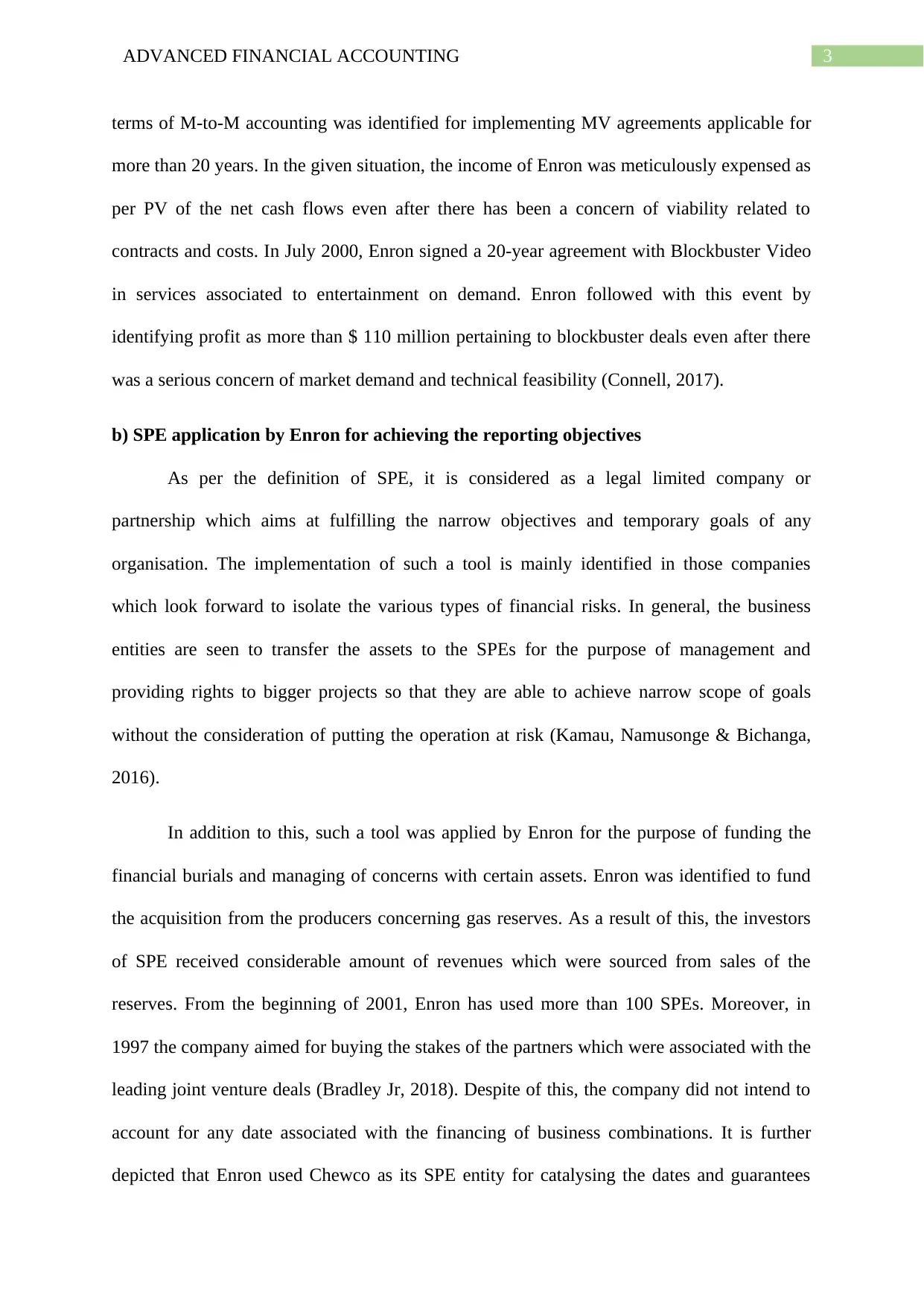
3ADVANCED FINANCIAL ACCOUNTING
terms of M-to-M accounting was identified for implementing MV agreements applicable for
more than 20 years. In the given situation, the income of Enron was meticulously expensed as
per PV of the net cash flows even after there has been a concern of viability related to
contracts and costs. In July 2000, Enron signed a 20-year agreement with Blockbuster Video
in services associated to entertainment on demand. Enron followed with this event by
identifying profit as more than $ 110 million pertaining to blockbuster deals even after there
was a serious concern of market demand and technical feasibility (Connell, 2017).
b) SPE application by Enron for achieving the reporting objectives
As per the definition of SPE, it is considered as a legal limited company or
partnership which aims at fulfilling the narrow objectives and temporary goals of any
organisation. The implementation of such a tool is mainly identified in those companies
which look forward to isolate the various types of financial risks. In general, the business
entities are seen to transfer the assets to the SPEs for the purpose of management and
providing rights to bigger projects so that they are able to achieve narrow scope of goals
without the consideration of putting the operation at risk (Kamau, Namusonge & Bichanga,
2016).
In addition to this, such a tool was applied by Enron for the purpose of funding the
financial burials and managing of concerns with certain assets. Enron was identified to fund
the acquisition from the producers concerning gas reserves. As a result of this, the investors
of SPE received considerable amount of revenues which were sourced from sales of the
reserves. From the beginning of 2001, Enron has used more than 100 SPEs. Moreover, in
1997 the company aimed for buying the stakes of the partners which were associated with the
leading joint venture deals (Bradley Jr, 2018). Despite of this, the company did not intend to
account for any date associated with the financing of business combinations. It is further
depicted that Enron used Chewco as its SPE entity for catalysing the dates and guarantees
terms of M-to-M accounting was identified for implementing MV agreements applicable for
more than 20 years. In the given situation, the income of Enron was meticulously expensed as
per PV of the net cash flows even after there has been a concern of viability related to
contracts and costs. In July 2000, Enron signed a 20-year agreement with Blockbuster Video
in services associated to entertainment on demand. Enron followed with this event by
identifying profit as more than $ 110 million pertaining to blockbuster deals even after there
was a serious concern of market demand and technical feasibility (Connell, 2017).
b) SPE application by Enron for achieving the reporting objectives
As per the definition of SPE, it is considered as a legal limited company or
partnership which aims at fulfilling the narrow objectives and temporary goals of any
organisation. The implementation of such a tool is mainly identified in those companies
which look forward to isolate the various types of financial risks. In general, the business
entities are seen to transfer the assets to the SPEs for the purpose of management and
providing rights to bigger projects so that they are able to achieve narrow scope of goals
without the consideration of putting the operation at risk (Kamau, Namusonge & Bichanga,
2016).
In addition to this, such a tool was applied by Enron for the purpose of funding the
financial burials and managing of concerns with certain assets. Enron was identified to fund
the acquisition from the producers concerning gas reserves. As a result of this, the investors
of SPE received considerable amount of revenues which were sourced from sales of the
reserves. From the beginning of 2001, Enron has used more than 100 SPEs. Moreover, in
1997 the company aimed for buying the stakes of the partners which were associated with the
leading joint venture deals (Bradley Jr, 2018). Despite of this, the company did not intend to
account for any date associated with the financing of business combinations. It is further
depicted that Enron used Chewco as its SPE entity for catalysing the dates and guarantees
Secure Best Marks with AI Grader
Need help grading? Try our AI Grader for instant feedback on your assignments.
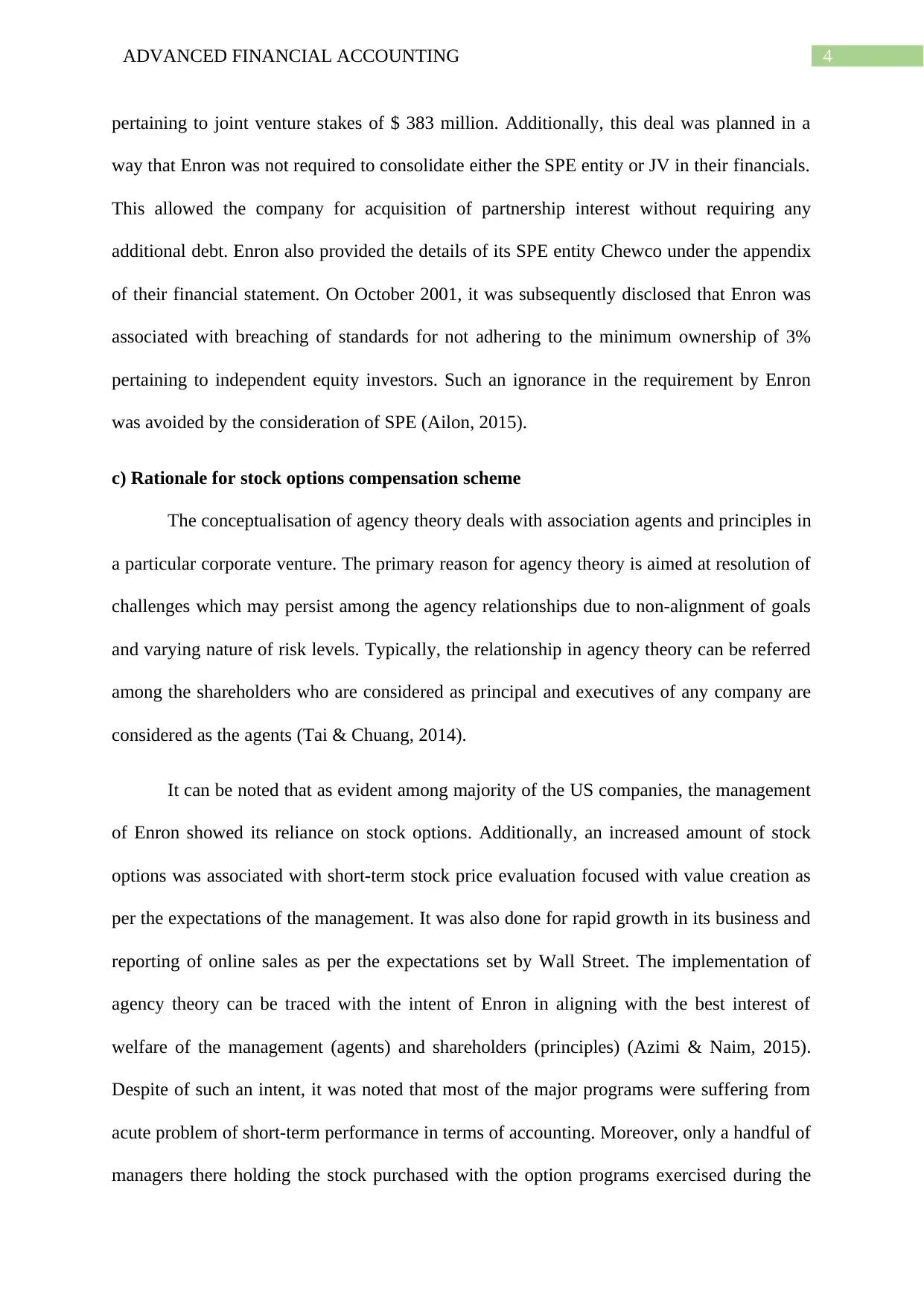
4ADVANCED FINANCIAL ACCOUNTING
pertaining to joint venture stakes of $ 383 million. Additionally, this deal was planned in a
way that Enron was not required to consolidate either the SPE entity or JV in their financials.
This allowed the company for acquisition of partnership interest without requiring any
additional debt. Enron also provided the details of its SPE entity Chewco under the appendix
of their financial statement. On October 2001, it was subsequently disclosed that Enron was
associated with breaching of standards for not adhering to the minimum ownership of 3%
pertaining to independent equity investors. Such an ignorance in the requirement by Enron
was avoided by the consideration of SPE (Ailon, 2015).
c) Rationale for stock options compensation scheme
The conceptualisation of agency theory deals with association agents and principles in
a particular corporate venture. The primary reason for agency theory is aimed at resolution of
challenges which may persist among the agency relationships due to non-alignment of goals
and varying nature of risk levels. Typically, the relationship in agency theory can be referred
among the shareholders who are considered as principal and executives of any company are
considered as the agents (Tai & Chuang, 2014).
It can be noted that as evident among majority of the US companies, the management
of Enron showed its reliance on stock options. Additionally, an increased amount of stock
options was associated with short-term stock price evaluation focused with value creation as
per the expectations of the management. It was also done for rapid growth in its business and
reporting of online sales as per the expectations set by Wall Street. The implementation of
agency theory can be traced with the intent of Enron in aligning with the best interest of
welfare of the management (agents) and shareholders (principles) (Azimi & Naim, 2015).
Despite of such an intent, it was noted that most of the major programs were suffering from
acute problem of short-term performance in terms of accounting. Moreover, only a handful of
managers there holding the stock purchased with the option programs exercised during the
pertaining to joint venture stakes of $ 383 million. Additionally, this deal was planned in a
way that Enron was not required to consolidate either the SPE entity or JV in their financials.
This allowed the company for acquisition of partnership interest without requiring any
additional debt. Enron also provided the details of its SPE entity Chewco under the appendix
of their financial statement. On October 2001, it was subsequently disclosed that Enron was
associated with breaching of standards for not adhering to the minimum ownership of 3%
pertaining to independent equity investors. Such an ignorance in the requirement by Enron
was avoided by the consideration of SPE (Ailon, 2015).
c) Rationale for stock options compensation scheme
The conceptualisation of agency theory deals with association agents and principles in
a particular corporate venture. The primary reason for agency theory is aimed at resolution of
challenges which may persist among the agency relationships due to non-alignment of goals
and varying nature of risk levels. Typically, the relationship in agency theory can be referred
among the shareholders who are considered as principal and executives of any company are
considered as the agents (Tai & Chuang, 2014).
It can be noted that as evident among majority of the US companies, the management
of Enron showed its reliance on stock options. Additionally, an increased amount of stock
options was associated with short-term stock price evaluation focused with value creation as
per the expectations of the management. It was also done for rapid growth in its business and
reporting of online sales as per the expectations set by Wall Street. The implementation of
agency theory can be traced with the intent of Enron in aligning with the best interest of
welfare of the management (agents) and shareholders (principles) (Azimi & Naim, 2015).
Despite of such an intent, it was noted that most of the major programs were suffering from
acute problem of short-term performance in terms of accounting. Moreover, only a handful of
managers there holding the stock purchased with the option programs exercised during the
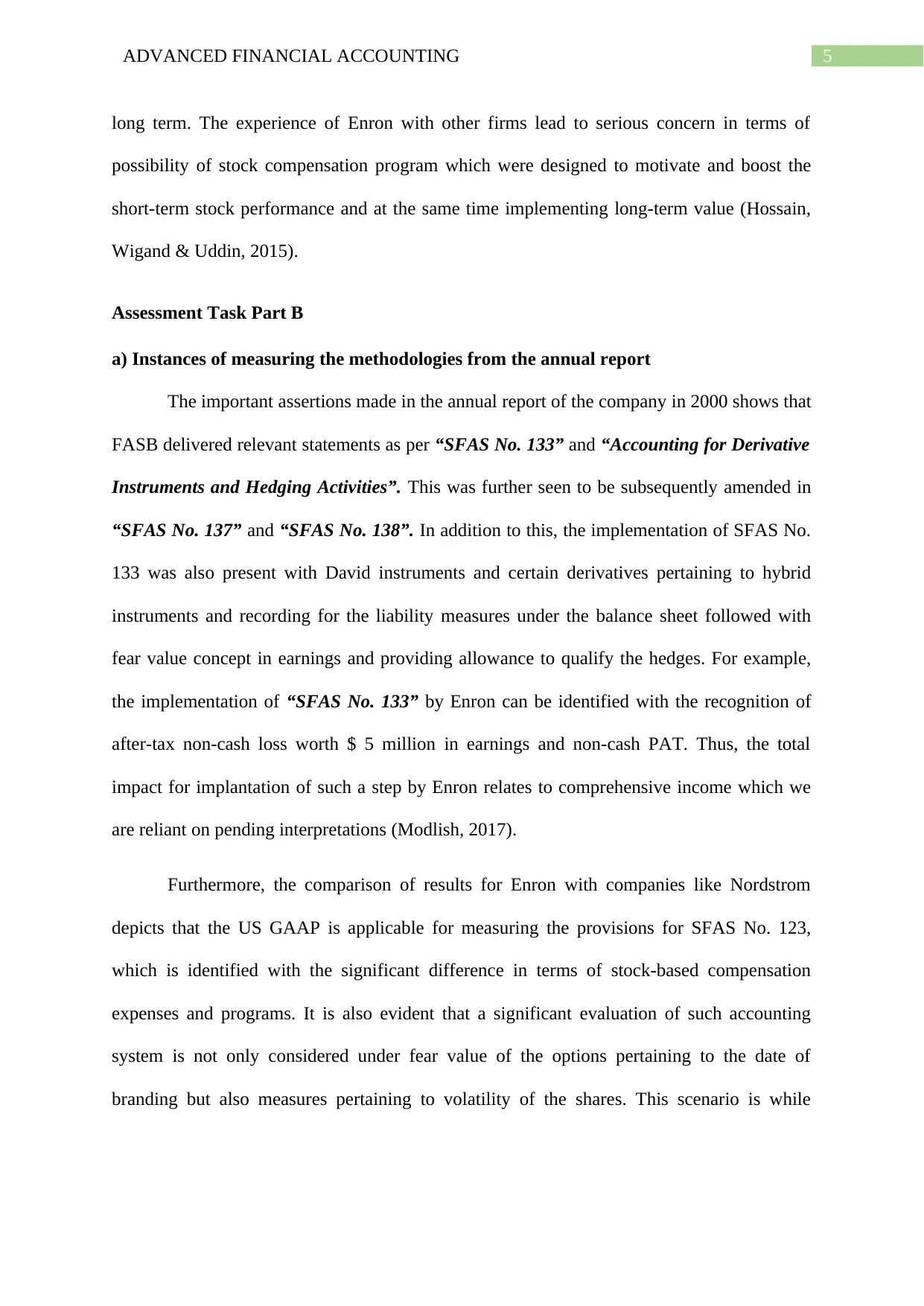
5ADVANCED FINANCIAL ACCOUNTING
long term. The experience of Enron with other firms lead to serious concern in terms of
possibility of stock compensation program which were designed to motivate and boost the
short-term stock performance and at the same time implementing long-term value (Hossain,
Wigand & Uddin, 2015).
Assessment Task Part B
a) Instances of measuring the methodologies from the annual report
The important assertions made in the annual report of the company in 2000 shows that
FASB delivered relevant statements as per “SFAS No. 133” and “Accounting for Derivative
Instruments and Hedging Activities”. This was further seen to be subsequently amended in
“SFAS No. 137” and “SFAS No. 138”. In addition to this, the implementation of SFAS No.
133 was also present with David instruments and certain derivatives pertaining to hybrid
instruments and recording for the liability measures under the balance sheet followed with
fear value concept in earnings and providing allowance to qualify the hedges. For example,
the implementation of “SFAS No. 133” by Enron can be identified with the recognition of
after-tax non-cash loss worth $ 5 million in earnings and non-cash PAT. Thus, the total
impact for implantation of such a step by Enron relates to comprehensive income which we
are reliant on pending interpretations (Modlish, 2017).
Furthermore, the comparison of results for Enron with companies like Nordstrom
depicts that the US GAAP is applicable for measuring the provisions for SFAS No. 123,
which is identified with the significant difference in terms of stock-based compensation
expenses and programs. It is also evident that a significant evaluation of such accounting
system is not only considered under fear value of the options pertaining to the date of
branding but also measures pertaining to volatility of the shares. This scenario is while
long term. The experience of Enron with other firms lead to serious concern in terms of
possibility of stock compensation program which were designed to motivate and boost the
short-term stock performance and at the same time implementing long-term value (Hossain,
Wigand & Uddin, 2015).
Assessment Task Part B
a) Instances of measuring the methodologies from the annual report
The important assertions made in the annual report of the company in 2000 shows that
FASB delivered relevant statements as per “SFAS No. 133” and “Accounting for Derivative
Instruments and Hedging Activities”. This was further seen to be subsequently amended in
“SFAS No. 137” and “SFAS No. 138”. In addition to this, the implementation of SFAS No.
133 was also present with David instruments and certain derivatives pertaining to hybrid
instruments and recording for the liability measures under the balance sheet followed with
fear value concept in earnings and providing allowance to qualify the hedges. For example,
the implementation of “SFAS No. 133” by Enron can be identified with the recognition of
after-tax non-cash loss worth $ 5 million in earnings and non-cash PAT. Thus, the total
impact for implantation of such a step by Enron relates to comprehensive income which we
are reliant on pending interpretations (Modlish, 2017).
Furthermore, the comparison of results for Enron with companies like Nordstrom
depicts that the US GAAP is applicable for measuring the provisions for SFAS No. 123,
which is identified with the significant difference in terms of stock-based compensation
expenses and programs. It is also evident that a significant evaluation of such accounting
system is not only considered under fear value of the options pertaining to the date of
branding but also measures pertaining to volatility of the shares. This scenario is while
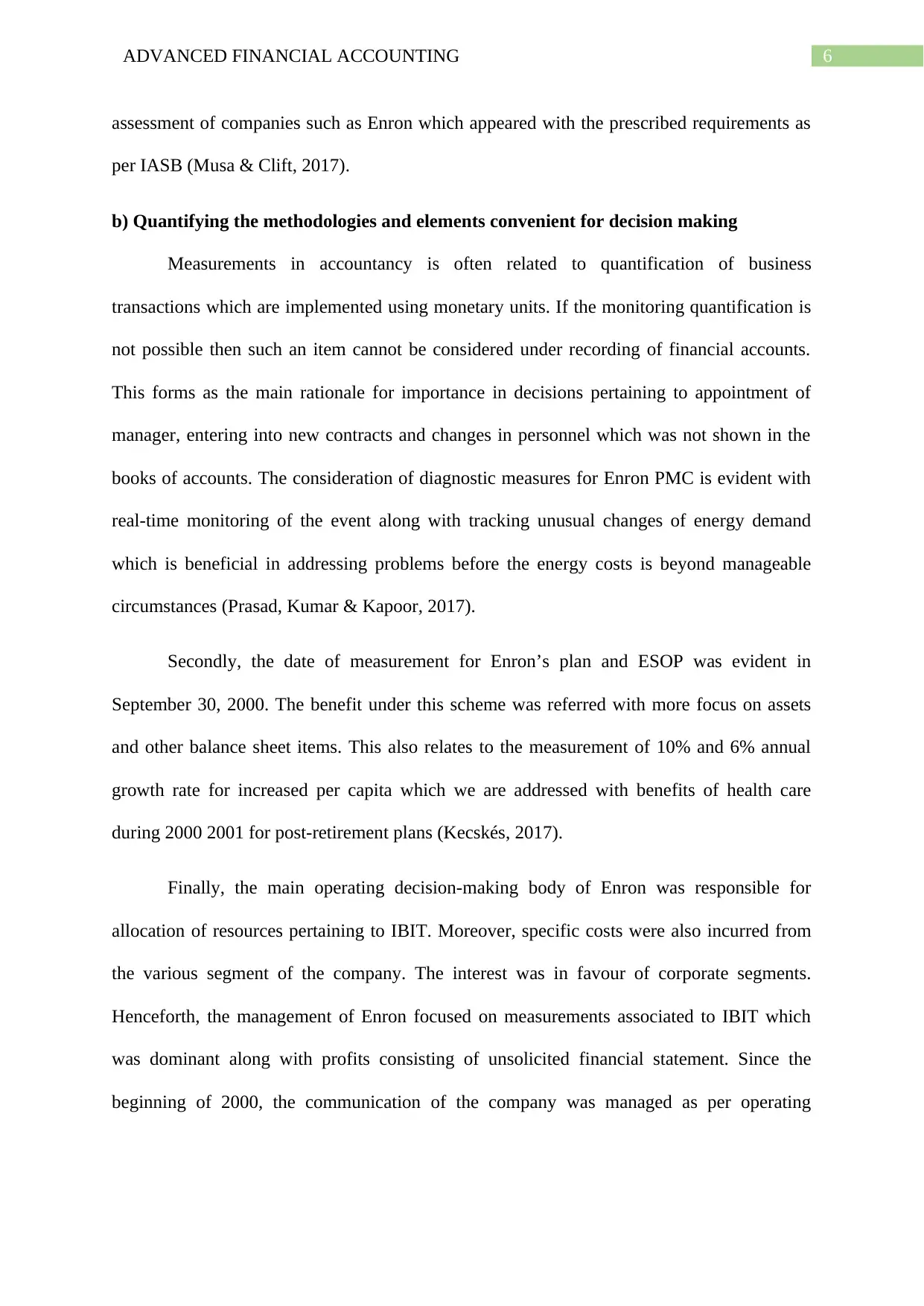
6ADVANCED FINANCIAL ACCOUNTING
assessment of companies such as Enron which appeared with the prescribed requirements as
per IASB (Musa & Clift, 2017).
b) Quantifying the methodologies and elements convenient for decision making
Measurements in accountancy is often related to quantification of business
transactions which are implemented using monetary units. If the monitoring quantification is
not possible then such an item cannot be considered under recording of financial accounts.
This forms as the main rationale for importance in decisions pertaining to appointment of
manager, entering into new contracts and changes in personnel which was not shown in the
books of accounts. The consideration of diagnostic measures for Enron PMC is evident with
real-time monitoring of the event along with tracking unusual changes of energy demand
which is beneficial in addressing problems before the energy costs is beyond manageable
circumstances (Prasad, Kumar & Kapoor, 2017).
Secondly, the date of measurement for Enron’s plan and ESOP was evident in
September 30, 2000. The benefit under this scheme was referred with more focus on assets
and other balance sheet items. This also relates to the measurement of 10% and 6% annual
growth rate for increased per capita which we are addressed with benefits of health care
during 2000 2001 for post-retirement plans (Kecskés, 2017).
Finally, the main operating decision-making body of Enron was responsible for
allocation of resources pertaining to IBIT. Moreover, specific costs were also incurred from
the various segment of the company. The interest was in favour of corporate segments.
Henceforth, the management of Enron focused on measurements associated to IBIT which
was dominant along with profits consisting of unsolicited financial statement. Since the
beginning of 2000, the communication of the company was managed as per operating
assessment of companies such as Enron which appeared with the prescribed requirements as
per IASB (Musa & Clift, 2017).
b) Quantifying the methodologies and elements convenient for decision making
Measurements in accountancy is often related to quantification of business
transactions which are implemented using monetary units. If the monitoring quantification is
not possible then such an item cannot be considered under recording of financial accounts.
This forms as the main rationale for importance in decisions pertaining to appointment of
manager, entering into new contracts and changes in personnel which was not shown in the
books of accounts. The consideration of diagnostic measures for Enron PMC is evident with
real-time monitoring of the event along with tracking unusual changes of energy demand
which is beneficial in addressing problems before the energy costs is beyond manageable
circumstances (Prasad, Kumar & Kapoor, 2017).
Secondly, the date of measurement for Enron’s plan and ESOP was evident in
September 30, 2000. The benefit under this scheme was referred with more focus on assets
and other balance sheet items. This also relates to the measurement of 10% and 6% annual
growth rate for increased per capita which we are addressed with benefits of health care
during 2000 2001 for post-retirement plans (Kecskés, 2017).
Finally, the main operating decision-making body of Enron was responsible for
allocation of resources pertaining to IBIT. Moreover, specific costs were also incurred from
the various segment of the company. The interest was in favour of corporate segments.
Henceforth, the management of Enron focused on measurements associated to IBIT which
was dominant along with profits consisting of unsolicited financial statement. Since the
beginning of 2000, the communication of the company was managed as per operating
Paraphrase This Document
Need a fresh take? Get an instant paraphrase of this document with our AI Paraphraser
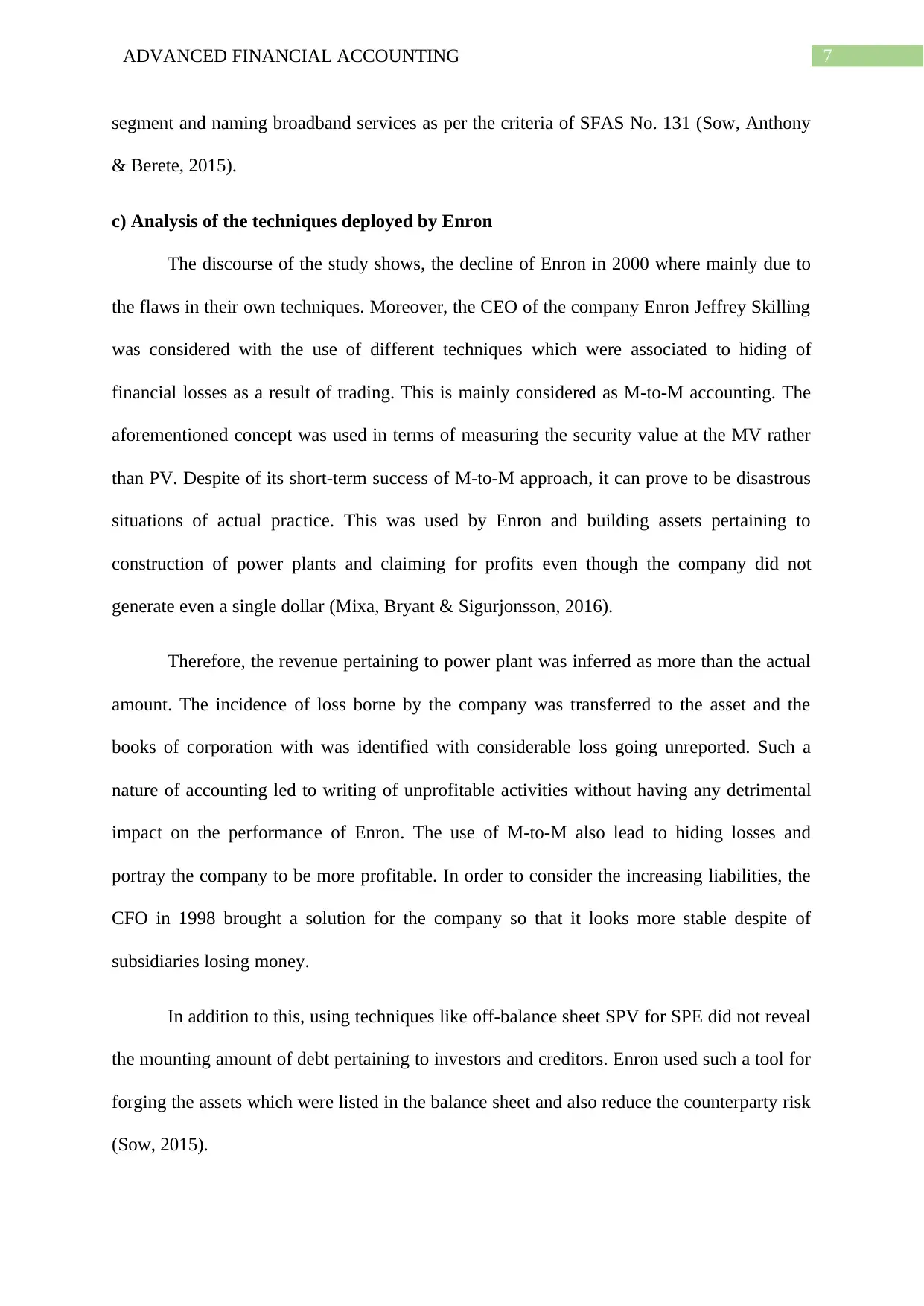
7ADVANCED FINANCIAL ACCOUNTING
segment and naming broadband services as per the criteria of SFAS No. 131 (Sow, Anthony
& Berete, 2015).
c) Analysis of the techniques deployed by Enron
The discourse of the study shows, the decline of Enron in 2000 where mainly due to
the flaws in their own techniques. Moreover, the CEO of the company Enron Jeffrey Skilling
was considered with the use of different techniques which were associated to hiding of
financial losses as a result of trading. This is mainly considered as M-to-M accounting. The
aforementioned concept was used in terms of measuring the security value at the MV rather
than PV. Despite of its short-term success of M-to-M approach, it can prove to be disastrous
situations of actual practice. This was used by Enron and building assets pertaining to
construction of power plants and claiming for profits even though the company did not
generate even a single dollar (Mixa, Bryant & Sigurjonsson, 2016).
Therefore, the revenue pertaining to power plant was inferred as more than the actual
amount. The incidence of loss borne by the company was transferred to the asset and the
books of corporation with was identified with considerable loss going unreported. Such a
nature of accounting led to writing of unprofitable activities without having any detrimental
impact on the performance of Enron. The use of M-to-M also lead to hiding losses and
portray the company to be more profitable. In order to consider the increasing liabilities, the
CFO in 1998 brought a solution for the company so that it looks more stable despite of
subsidiaries losing money.
In addition to this, using techniques like off-balance sheet SPV for SPE did not reveal
the mounting amount of debt pertaining to investors and creditors. Enron used such a tool for
forging the assets which were listed in the balance sheet and also reduce the counterparty risk
(Sow, 2015).
segment and naming broadband services as per the criteria of SFAS No. 131 (Sow, Anthony
& Berete, 2015).
c) Analysis of the techniques deployed by Enron
The discourse of the study shows, the decline of Enron in 2000 where mainly due to
the flaws in their own techniques. Moreover, the CEO of the company Enron Jeffrey Skilling
was considered with the use of different techniques which were associated to hiding of
financial losses as a result of trading. This is mainly considered as M-to-M accounting. The
aforementioned concept was used in terms of measuring the security value at the MV rather
than PV. Despite of its short-term success of M-to-M approach, it can prove to be disastrous
situations of actual practice. This was used by Enron and building assets pertaining to
construction of power plants and claiming for profits even though the company did not
generate even a single dollar (Mixa, Bryant & Sigurjonsson, 2016).
Therefore, the revenue pertaining to power plant was inferred as more than the actual
amount. The incidence of loss borne by the company was transferred to the asset and the
books of corporation with was identified with considerable loss going unreported. Such a
nature of accounting led to writing of unprofitable activities without having any detrimental
impact on the performance of Enron. The use of M-to-M also lead to hiding losses and
portray the company to be more profitable. In order to consider the increasing liabilities, the
CFO in 1998 brought a solution for the company so that it looks more stable despite of
subsidiaries losing money.
In addition to this, using techniques like off-balance sheet SPV for SPE did not reveal
the mounting amount of debt pertaining to investors and creditors. Enron used such a tool for
forging the assets which were listed in the balance sheet and also reduce the counterparty risk
(Sow, 2015).
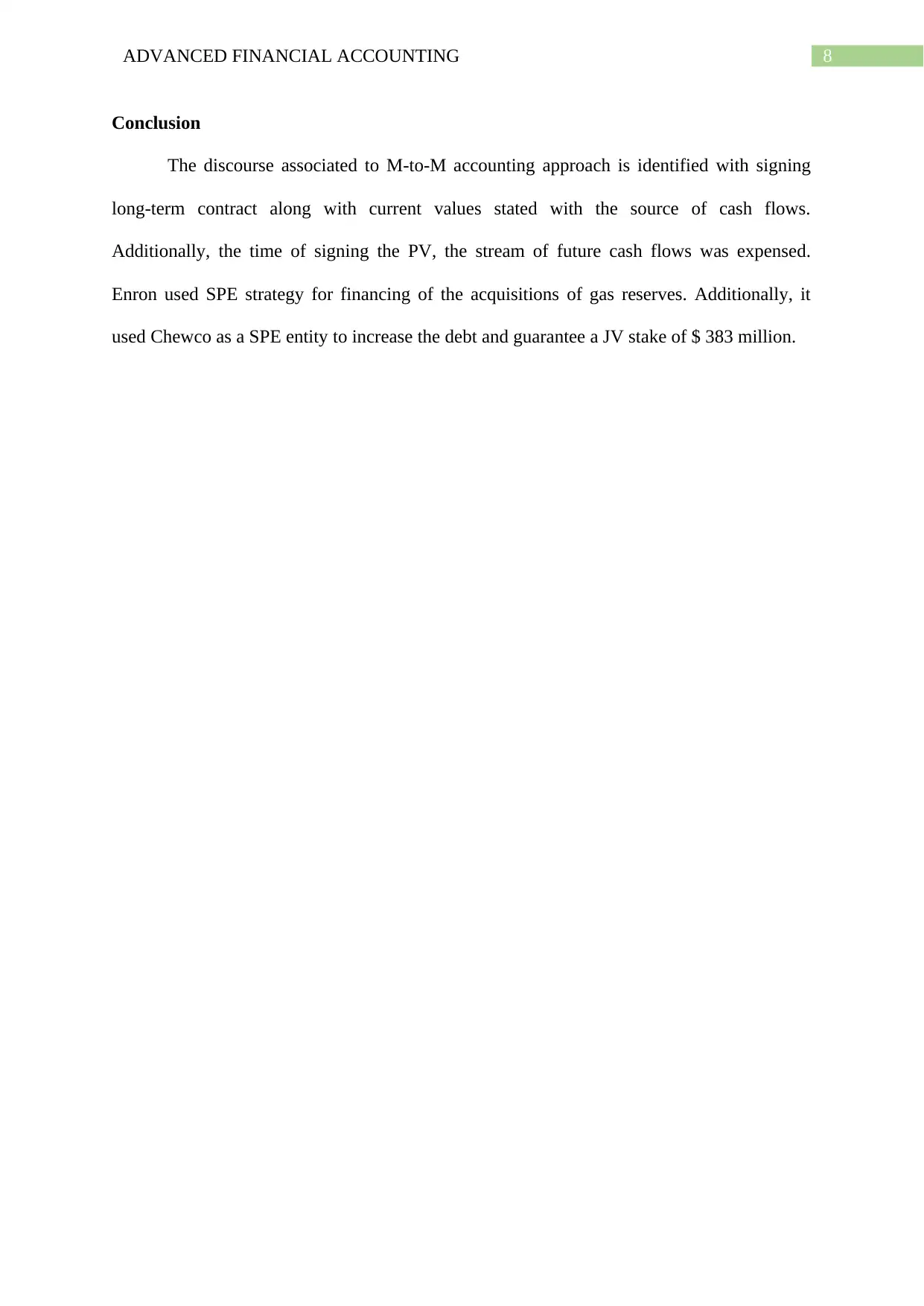
8ADVANCED FINANCIAL ACCOUNTING
Conclusion
The discourse associated to M-to-M accounting approach is identified with signing
long-term contract along with current values stated with the source of cash flows.
Additionally, the time of signing the PV, the stream of future cash flows was expensed.
Enron used SPE strategy for financing of the acquisitions of gas reserves. Additionally, it
used Chewco as a SPE entity to increase the debt and guarantee a JV stake of $ 383 million.
Conclusion
The discourse associated to M-to-M accounting approach is identified with signing
long-term contract along with current values stated with the source of cash flows.
Additionally, the time of signing the PV, the stream of future cash flows was expensed.
Enron used SPE strategy for financing of the acquisitions of gas reserves. Additionally, it
used Chewco as a SPE entity to increase the debt and guarantee a JV stake of $ 383 million.
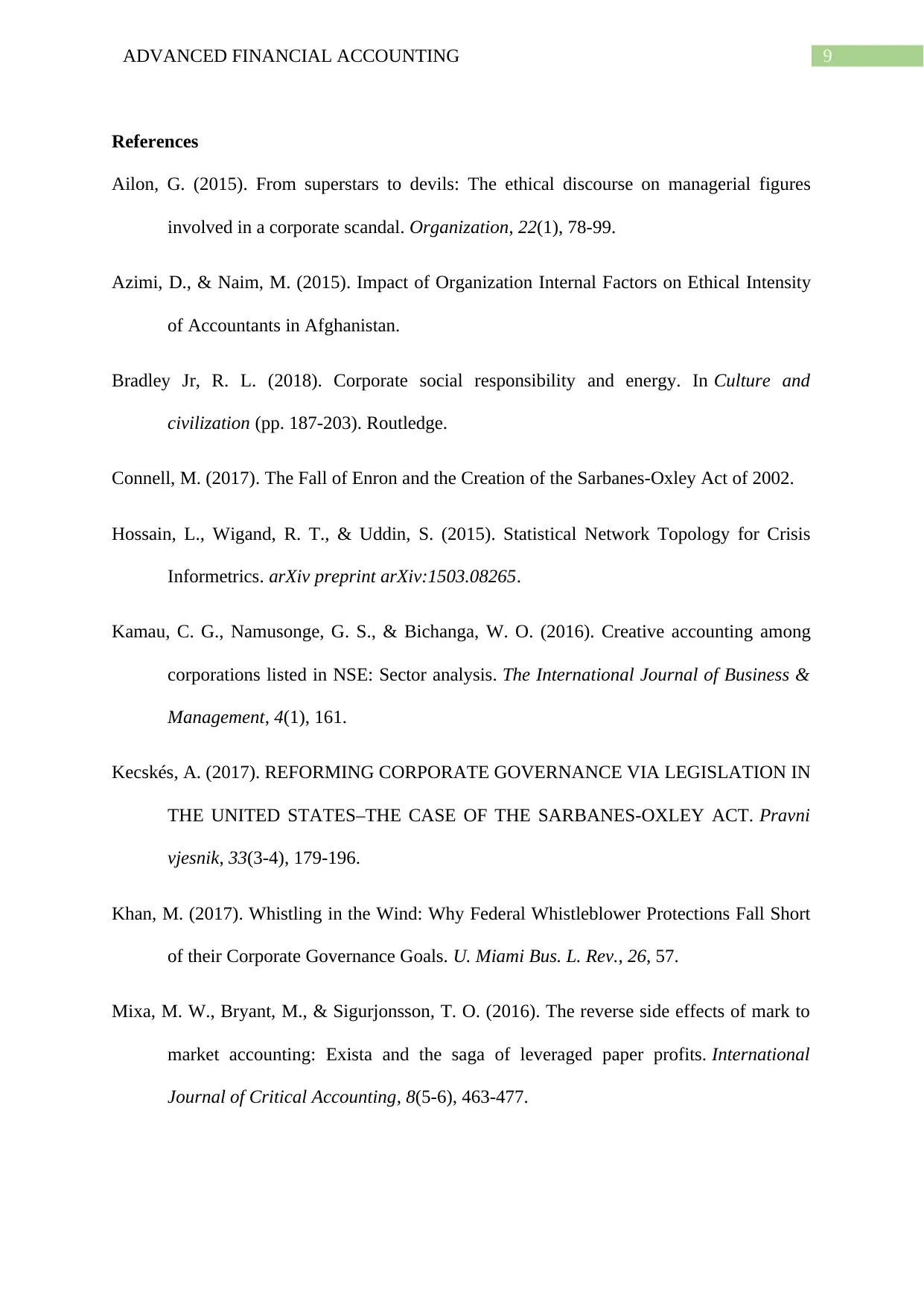
9ADVANCED FINANCIAL ACCOUNTING
References
Ailon, G. (2015). From superstars to devils: The ethical discourse on managerial figures
involved in a corporate scandal. Organization, 22(1), 78-99.
Azimi, D., & Naim, M. (2015). Impact of Organization Internal Factors on Ethical Intensity
of Accountants in Afghanistan.
Bradley Jr, R. L. (2018). Corporate social responsibility and energy. In Culture and
civilization (pp. 187-203). Routledge.
Connell, M. (2017). The Fall of Enron and the Creation of the Sarbanes-Oxley Act of 2002.
Hossain, L., Wigand, R. T., & Uddin, S. (2015). Statistical Network Topology for Crisis
Informetrics. arXiv preprint arXiv:1503.08265.
Kamau, C. G., Namusonge, G. S., & Bichanga, W. O. (2016). Creative accounting among
corporations listed in NSE: Sector analysis. The International Journal of Business &
Management, 4(1), 161.
Kecskés, A. (2017). REFORMING CORPORATE GOVERNANCE VIA LEGISLATION IN
THE UNITED STATES–THE CASE OF THE SARBANES-OXLEY ACT. Pravni
vjesnik, 33(3-4), 179-196.
Khan, M. (2017). Whistling in the Wind: Why Federal Whistleblower Protections Fall Short
of their Corporate Governance Goals. U. Miami Bus. L. Rev., 26, 57.
Mixa, M. W., Bryant, M., & Sigurjonsson, T. O. (2016). The reverse side effects of mark to
market accounting: Exista and the saga of leveraged paper profits. International
Journal of Critical Accounting, 8(5-6), 463-477.
References
Ailon, G. (2015). From superstars to devils: The ethical discourse on managerial figures
involved in a corporate scandal. Organization, 22(1), 78-99.
Azimi, D., & Naim, M. (2015). Impact of Organization Internal Factors on Ethical Intensity
of Accountants in Afghanistan.
Bradley Jr, R. L. (2018). Corporate social responsibility and energy. In Culture and
civilization (pp. 187-203). Routledge.
Connell, M. (2017). The Fall of Enron and the Creation of the Sarbanes-Oxley Act of 2002.
Hossain, L., Wigand, R. T., & Uddin, S. (2015). Statistical Network Topology for Crisis
Informetrics. arXiv preprint arXiv:1503.08265.
Kamau, C. G., Namusonge, G. S., & Bichanga, W. O. (2016). Creative accounting among
corporations listed in NSE: Sector analysis. The International Journal of Business &
Management, 4(1), 161.
Kecskés, A. (2017). REFORMING CORPORATE GOVERNANCE VIA LEGISLATION IN
THE UNITED STATES–THE CASE OF THE SARBANES-OXLEY ACT. Pravni
vjesnik, 33(3-4), 179-196.
Khan, M. (2017). Whistling in the Wind: Why Federal Whistleblower Protections Fall Short
of their Corporate Governance Goals. U. Miami Bus. L. Rev., 26, 57.
Mixa, M. W., Bryant, M., & Sigurjonsson, T. O. (2016). The reverse side effects of mark to
market accounting: Exista and the saga of leveraged paper profits. International
Journal of Critical Accounting, 8(5-6), 463-477.
Secure Best Marks with AI Grader
Need help grading? Try our AI Grader for instant feedback on your assignments.
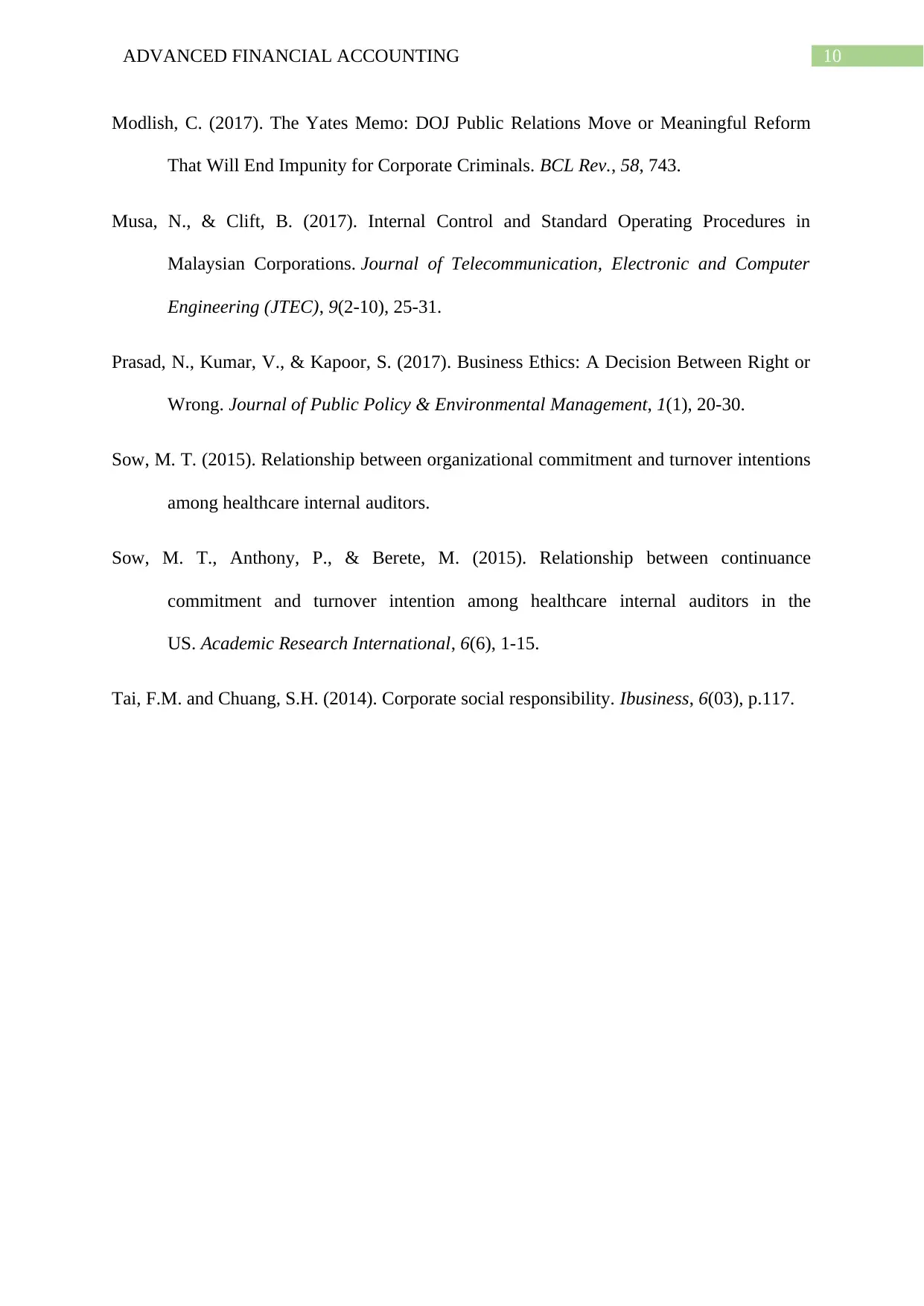
10ADVANCED FINANCIAL ACCOUNTING
Modlish, C. (2017). The Yates Memo: DOJ Public Relations Move or Meaningful Reform
That Will End Impunity for Corporate Criminals. BCL Rev., 58, 743.
Musa, N., & Clift, B. (2017). Internal Control and Standard Operating Procedures in
Malaysian Corporations. Journal of Telecommunication, Electronic and Computer
Engineering (JTEC), 9(2-10), 25-31.
Prasad, N., Kumar, V., & Kapoor, S. (2017). Business Ethics: A Decision Between Right or
Wrong. Journal of Public Policy & Environmental Management, 1(1), 20-30.
Sow, M. T. (2015). Relationship between organizational commitment and turnover intentions
among healthcare internal auditors.
Sow, M. T., Anthony, P., & Berete, M. (2015). Relationship between continuance
commitment and turnover intention among healthcare internal auditors in the
US. Academic Research International, 6(6), 1-15.
Tai, F.M. and Chuang, S.H. (2014). Corporate social responsibility. Ibusiness, 6(03), p.117.
Modlish, C. (2017). The Yates Memo: DOJ Public Relations Move or Meaningful Reform
That Will End Impunity for Corporate Criminals. BCL Rev., 58, 743.
Musa, N., & Clift, B. (2017). Internal Control and Standard Operating Procedures in
Malaysian Corporations. Journal of Telecommunication, Electronic and Computer
Engineering (JTEC), 9(2-10), 25-31.
Prasad, N., Kumar, V., & Kapoor, S. (2017). Business Ethics: A Decision Between Right or
Wrong. Journal of Public Policy & Environmental Management, 1(1), 20-30.
Sow, M. T. (2015). Relationship between organizational commitment and turnover intentions
among healthcare internal auditors.
Sow, M. T., Anthony, P., & Berete, M. (2015). Relationship between continuance
commitment and turnover intention among healthcare internal auditors in the
US. Academic Research International, 6(6), 1-15.
Tai, F.M. and Chuang, S.H. (2014). Corporate social responsibility. Ibusiness, 6(03), p.117.
1 out of 11
Related Documents
Your All-in-One AI-Powered Toolkit for Academic Success.
+13062052269
info@desklib.com
Available 24*7 on WhatsApp / Email
![[object Object]](/_next/static/media/star-bottom.7253800d.svg)
Unlock your academic potential
© 2024 | Zucol Services PVT LTD | All rights reserved.





